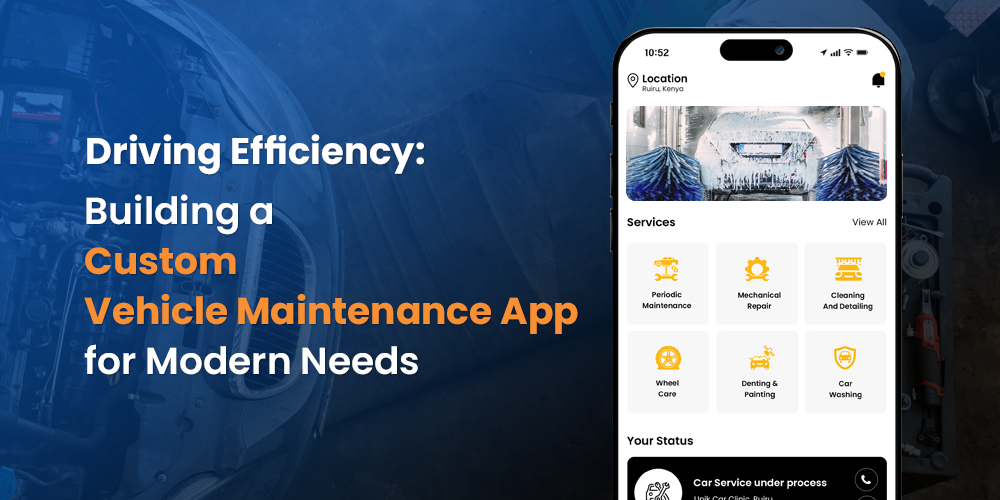Driving Efficiency: Building a Custom Vehicle Maintenance App for Modern Needs
Understanding the Demand
The automotive industry is witnessing a digital transformation. With the rise of connected vehicles and the Internet of Things (IoT), there’s an increasing demand for applications that offer real-time diagnostics, predictive maintenance, and seamless user experiences. Vehicle maintenance apps cater to this demand by providing users with tools to manage their vehicles proactively.
Key Features of a Vehicle Maintenance App
- User Profiles: Allow users to create profiles, add multiple vehicles, and customize settings.
- Maintenance Scheduling: Provide reminders for oil changes, tire rotations, and other routine services based on mileage or time intervals
- Service History Logs: Maintain records of past services, repairs, and inspections for each vehicle.
- Real-Time Diagnostics: Integrated with OBD-II devices to monitor vehicle health and alert users to potential issues.
- Fuel Tracking: Enable users to log fuel purchases, monitor consumption, and calculate efficiency.
- Expense Management: Track maintenance and repair costs, helping users budget effectively.
- Push Notifications: Send timely alerts for upcoming services, recalls, or detected issues.
- Service Center Locator: Assist users in finding nearby authorized service centers or mechanics.
- Cloud Syncing: Ensure data is backed up and accessible across multiple devices.
- Multi-Language Support: Cater to a diverse user base by offering multiple language options.
Development Process
1. Market Research
Begin by analyzing the target audience, understanding their needs, and studying competitors. Identify gaps in existing solutions and determine how your app can offer unique value.
2. Define Objectives
Clearly outline the app’s purpose. Are you targeting individual vehicle owners, fleet managers, or service centers? Defining objectives will guide feature selection and design decisions.
3. Design UI/UX
Focus on creating an intuitive and user-friendly interface. Ensure that navigation is straightforward and that information is presented clearly. A well-designed app enhances user engagement and satisfaction.
4. Choose the Right Technology Stack
Select technologies that align with your app’s requirements. For instance:
- Frontend: React Native or Flutter for cross-platform development.
- Backend: Node.js or Django for robust server-side operations.
- Database: MongoDB or PostgreSQL for efficient data management.
- APIs: Integrate third-party services for features like maps or diagnostics.
5. Develop and Test
Adopt an agile development approach, building the app in iterations. Regular testing ensures that features function correctly and the app remains bug-free.
6. Deployment
Once development is complete, deploy the app to platforms like Google Play Store and Apple App Store. Ensure compliance with platform guidelines and optimize listings for visibility.
7. Post-Launch Support
Gather user feedback to identify areas for improvement. Regular updates, feature enhancements, and prompt issue resolution are vital for long-term success.
Monetization Strategies
- Freemium Model: Offer basic features for free, with premium features available through subscriptions.
- In-App Advertising: Display relevant ads, ensuring they don’t disrupt the user experience.
- Affiliate Partnerships: Collaborate with service centers or parts suppliers, earning commissions on referrals.
- Data Analytics Services: Provide anonymized data insights to automotive businesses or researchers.
Challenges and Solutions
- Data Accuracy: Ensure that diagnostic data and service reminders are accurate to maintain user trust.
- User Engagement: Implement features that encourage regular app usage, such as gamification or rewards.
- Security Concerns: Protect user data with robust encryption and adhere to data protection regulations.
- Integration Issues: Ensure seamless integration with various vehicle models and third-party services.
Future Trends
- AI-powered predictive Maintenance: Using machine learning to predict potential issues before they occur.
- Blockchain for Service Records: Ensuring tamper-proof maintenance histories.
- Voice-Activated Interfaces: Allowing users to interact with the app hands-free.
- Augmented Reality (AR): Providing visual guides for basic maintenance tasks.

